Almost every more or less large industrial or commercial enterprise has warehouses for storing any product. Organization of the warehouse is an important stage in the development of the company. Today we will consider the concept, goals and methods of warehouse logistics, and also learn how it is organized in enterprises.
general information
Warehouse is called the premises in which the following procedures are carried out: acceptance, storage, distribution, processing of goods, as well as their delivery to the destination. The main objective of the warehouse is the accumulation of stocks and the supply of orders. Warehouse management is necessary so that stocks:
- Always been available.
- They did not spoil and did not lie down.
- Timely delivered to the warehouse and sent for delivery.
Warehouse logistics is a technology for managing the company's stocks and their movements. This system is an integral part of the cargo delivery system. Therefore, transport and warehouse logistics are closely related to each other.
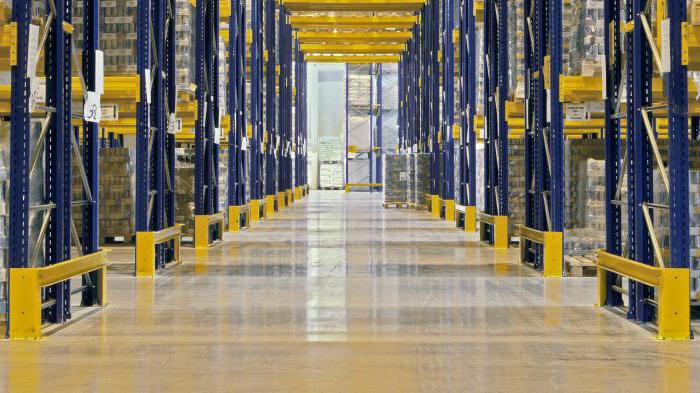
Warehouse Functions
A properly organized warehouse performs the following functions:
- Supply control - assortment formation. Lack of reserves is unacceptable, exactly, as well as their oversupply. Both that and another entails an increase in expenses of the company.
- Unitization of parties - the formation of large parties from small ones. Provides timely delivery to various customer companies.
- Acceptance of goods and its shipment. This function most closely combines warehouse logistics with transport. It also includes such secondary operations as quantity verification, quality control, product processing, and document processing.
- Warehousing and storage of goods.
- Other logistics services: unpacking, packaging, and assembly of products, as well as testing of devices.
At the warehouse, products can move within the framework of such flows:
- Incoming. The goods arriving at the warehouse must be unloaded, their quantity checked and the documentation accompanying them processed.
- Interior. In the warehouse, goods are moved, sorted, processed, formed in the party. In addition, this flow includes the execution of warehouse documents for products.
- Outgoing. Before releasing products from the warehouse, they must be packaged, loaded and the relevant documentation prepared.
What are the warehouses
In the warehouse logistics system, warehouses are classified according to a number of criteria.
By appointment:
- Production (workshop and factory).
- Transit and transportation. Valid at seaports, railway stations or airports. Necessary for short-term storage of goods, in between the main movements.
- Customs They store goods before passing through customs.
- Early delivery. They are used to prepare the assortment in places where seasonality of sales takes place.
- Seasonal storage. Needed to store seasonal goods.
- Reserve. Equipped for storing emergency supplies.
- Wholesale and distribution. They are necessary for the normal functioning of the distribution chain.
- Commercial. Available for rent to various users.
- Retail trading companies.
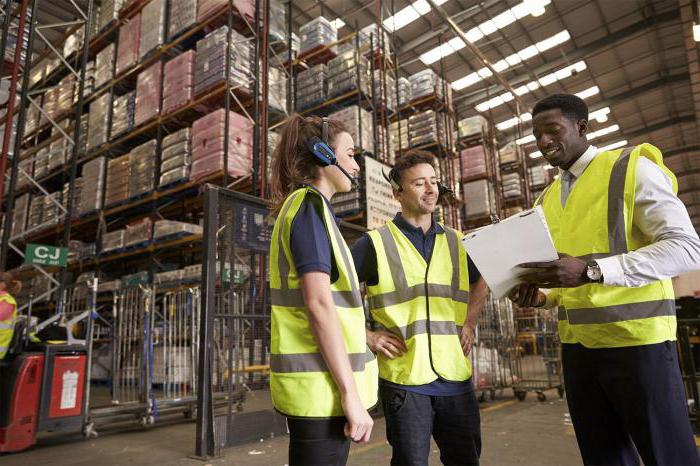
By design:
- Open.
- Closed.
- Semi-closed (for example, using canopies).
- Multi-storey.
According to storage conditions:
- Universal (general purpose).
- Specialized (for example, for frozen foods).
- Tanks for liquids.
- Repositories.
- For hazardous substances.
By type of goods:
- Finished products.
- Raw or semi-finished products.
- Waste and residues.
- Tools.
For interaction with other parts of the logistics system, there are warehouses:
- The manufacturer.
- Forwarding organization.
- Transport organization.
- Intermediary company.
- Trading company.
In terms of equipment:
- Partially mechanized.
- Fully mechanized.
- Automated.
- Automatic.
Organization of warehouse logistics: principles
The formation of a warehouse logistics system includes the following stages:
- Calculation of the area of warehouses and their quantity.
- The choice between building your warehouse or renting someone else's.
- Choosing a warehouse location.
- The choice of a system of warehousing and goods management.
- Warehouse equipment.
- Establishment of information flows.
- Hiring and training employees.
- Warehouse launch.
- Control of stocked products.
Next, we consider separately all the tasks of warehouse logistics.
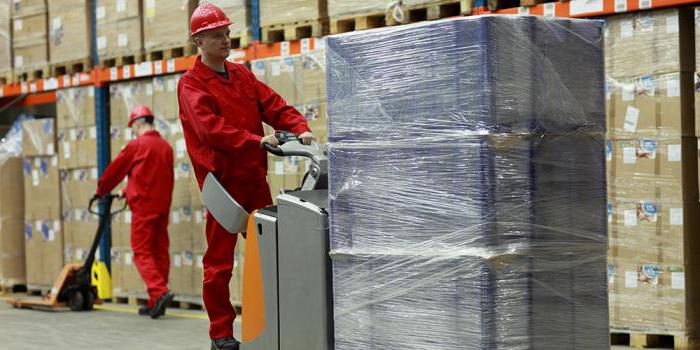
Quantity, area and location
The number of warehouses and their area greatly affect the profitability of the enterprise. The fewer warehouses at different points, the more you need to spend money on transportation. On the other hand, the more warehouses, the more expensive their maintenance. Therefore, before deciding on the number of storage facilities, it is necessary to compare all expenses with expected revenues. When determining a site for a warehouse, you need to focus on minimizing the cost of transporting products.
Own or leased warehouse?
The functions of warehouse logistics can be implemented in your own warehouse, or you can transfer them to another company as part of outsourcing. As a rule, those firms that do not yet have sufficient funds to build a personal warehouse resort to the latter option.
Compared with the independent organization of the warehouse, renting someone else’s premises:
- It costs more. You need to invest money in your warehouse only once, and you need to pay for the rent constantly.
- Reduces the growth prospects of the company.
- Improves the quality of services.
- Accelerates the development of skills.
To decide which option to choose, you need to weigh the costs of rent and construction, as well as the period for which they pay off.
How to choose an outsourcing company?
If you decide to still use the services of supporters of individuals, then pay attention to such points:
- If the company is large, then it should be connected by a single information flow.
- The company must process orders quickly and execute them accurately.
- Experience in this industry is perhaps the most important indicator.
- Before using the services of the company, it is worth paying attention to the feedback of previous customers.
- A good firm should provide a wide range of services, in addition to warehousing. This may be, for example, transport services and customs logistics. This is very convenient, since transport and warehouse logistics are closely related to each other.

Storage system
The organization of warehouse logistics involves the selection of:
- Warehouse units (tanks, boxes, etc.).
- Type of storage (blocks, stacks, racks and so on).
- Type of storage (varietal, batch, batch-varietal, by name).
- Special equipment.
- Product picking systems.
Rational layout
At the planning stage of the warehouse, it is necessary to develop a scheme for allocating stocks, as well as provide for the possibility of leaving, monitoring and monitoring them. The more rational the layout, the more efficient the warehouse logistics. At this stage, it is necessary to take into account the volumes of receipts and shipments, as well as their frequency. Consumer goods are placed closer to the shipment zone, and the rest - away so as not to interfere.
The rational layout of the warehouse includes:
- Definition of working areas.
- Efficient use of space.
- Use of universal equipment.
- Arrangement of the most open space, with a minimum of columns and walls.
- Use of empty space above racks.
- Arrangement of auxiliary premises (household, administrative, technical and so on).
Proper product placement implies that:
- The goods are located along the route, on both sides of the corridor.
- The packaging turns to the corridor.
- On the upper racks are placed goods for long storage.
The warehouse must be equipped with:
- Communications.
- Shelving.
- Ventilation or air conditioning.
- Fire safety equipment.
- Security systems.
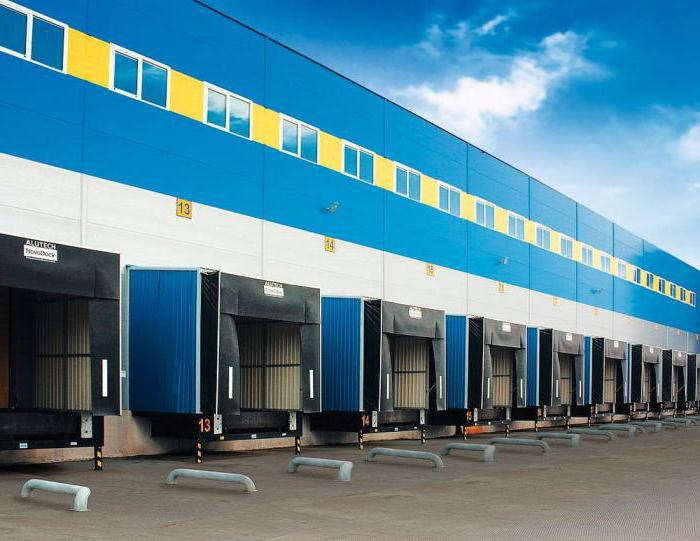
Organization of information flow
The documentation that comes with the product must not only be processed, but also systematized. At any time, information should be available on each item of goods stored in the warehouse. When leaving the warehouse, the cargo must be accompanied by documents describing its condition and the direction of transportation.
The flow of information is processed:
- In manual mode.
- In batch mode.
- In real time.
- In online mode.
Warehouse accounting documentation includes:
- Source documents. They accompany each movement of goods, their receipt for storage and delivery to the customer. They indicate the quantity of the product and its type.
- Shipping documents. These include: invoice and invoice. They accompany the cargo when it moves from the supplier to the customer.
- Journal of goods receipt. Designed to account for primary documents. It is filled when the goods arrive at the warehouse.
- Power of attorney to receive the goods.
- Form for registration of issued powers of attorney.
- A receipt order for accounting acceptance of processed products.
- Demand invoice. It registers the movement of goods between individuals and units within the enterprise.
- Material accounting card. Classifies goods and tracks their movement.
- Invoice for the release of goods. It is necessary when the goods need to be transported to a third-party organization or branch.
Staff recruitment
The number of warehouse workers depends on the volume of the business and can vary from one or two employees to several thousand.
Main warehouse positions:
- Head of Responsible for the products.
- Accountant (controller) of the warehouse. It records goods.
- Storekeeper. Accepts and issues the goods.
- Loader.
- Loader operator.
- Packer and picker. Sort and complete products.
- Marker. Marks incoming goods.
- Watchman. They monitor the safety of stocks after hours.
It’s not worth saving on personnel. The warehouse logistics department and each employee separately must clearly understand and freely perform their functions. The irrational use of personnel is one of the main problems of warehouse logistics in the countries of the former CIS.
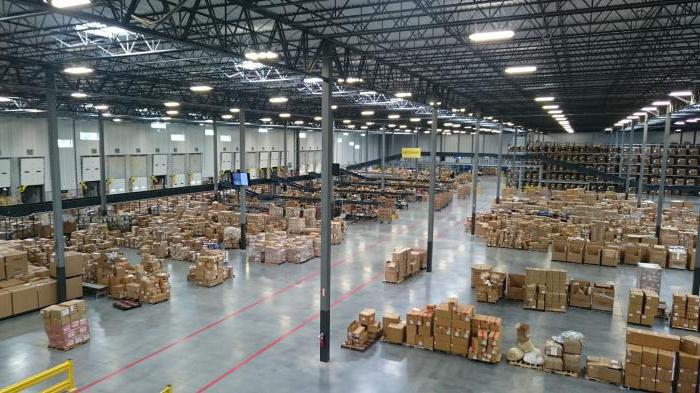
Control and management
Optimization of warehouse logistics is the key to effective control over the work of the warehouse. The management of the goods is considered successful if there is always as much goods in the warehouse as is necessary for sale. At the same time, stocks should be considered not as a whole, but separately for each item.
There are three types of product promotion system through sales channels:
- Pulling channels. Goods are shipped as soon as an order is received.
- Pushing channels. Products are issued to suppliers according to a schedule agreed in advance.
- Combined channels. Assume the use of computer communication between the manufacturer, intermediary, seller and buyer.
Modern warehouse logistics is simplified thanks to new information systems that allow the manager to track all processes without leaving his office.
Packaging
Transportation and storage of any cargo is impossible without packaging and packaging.
In warehouse logistics, packaging has many functions. Here are the main ones:
- Protective.Properly selected packaging protects products from the influence of the external environment at all stages of transportation and storage.
- Warehousing, handling and transport. The packaging must withstand the loading and unloading of goods. In addition, its shape should facilitate convenient storage and unhindered manipulation.
- Information (identification). By packaging, you can find out the name of the product, who made it, shelf life, etc.
- Recycling. Warehouse logistics systems also include recycling and packaging recycling.
Packaging is a type of packaging that is used at the stages of transportation, loading, unloading and storage, to prevent damage to products.
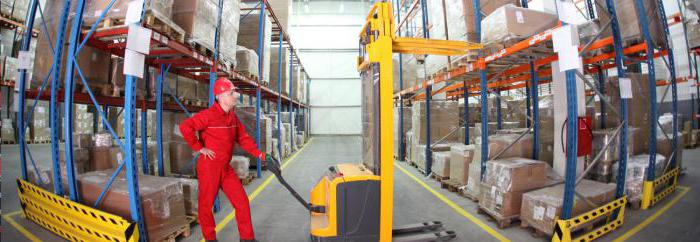
Tara is classified according to a number of signs:
- Material: wooden, metal, glass, or combined.
- Dimensions: large and small.
- Use time: one-time, returnable and negotiable.
- Fortress: hard, semi-rigid and soft.
- Device: collapsible, folding, collapsible, collapsible.
- Properties: unpressurized, preserving temperature or pressure.
- Access: open or closed.
- Appointment: transportation or consumer.
Warehouse logistics in the CIS countries
To date, the logistics of warehousing in the post-Soviet countries is very poorly developed. This is due to:
- Lack of qualified personnel.
- Weak logistics infrastructure.
- Outdated logistics technology.
- Lack of knowledge about warehouse management.
- Misunderstanding of the problems of the enterprise by the management.
Nevertheless, the demand for warehouse services is growing annually, which means that there is a serious incentive for the development of the industry. Warehouse logistics management should not be underestimated - it is a very painstaking work that needs constant attention. Not a single warehouse, even the smallest one, can function normally if its processes are not controlled. It is necessary to cultivate professional warehouse logistics. And then it is likely that in our latitudes world standards of warehouse logistics will be reached.